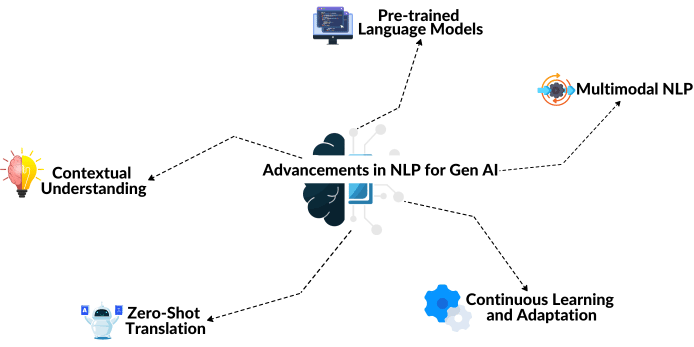
Advancements in Natural Language Processing for Gen AI: Breaking Language Barriers

Seema Karwa
Head of Sales
Some recent events in my life which triggered thoughts about Natural Language Processing (NLP) in my mind. Let’s see some of these events before we talk about advancements in NLP:
- While I was interviewing last year with a few companies to scale up their businesses across geographies, a common question which came was - How would you overcome language barrier if you were to think of expansion in a non-English speaking country?
- Early part of this year, I went to Vietnam where I had to constantly use Google translator to communicate with my tourist guide as he would not understand English. It became difficult to have a conversation (Google translator is an example of machine translation & not Gen AI. AI systems which have Gen AI possess more advanced cognitive abilities, including ability to learn, reason & making decisions autonomously)
- Recently, in a meeting with a client from middle east; the client was curious to understand how we would make sense of the large amount of data in Arabic & help him use Gen AI?
Recent breakthroughs in NLP have ushered in a new era of language understanding and translation, creating a more inclusive and connected world. It can successfully solve for all of the above situations. Let’s understand some of the advancements in NLP for Gen AI:

-
Pre-trained Language Models
One of the key advancements in NLP is the development of pre-trained language models like GPT-3.5. These models have been trained on vast amounts of text from multiple languages, allowing them to understand and generate human-like text in various tongues. Gen AI can now leverage these models to comprehend and converse in different languages, making language barriers virtually non-existent.
-
Zero-Shot Translation
Zero-shot translation is a remarkable feature made possible by advancements in NLP. It enables a language model to translate between language pairs that it hasn't been explicitly trained on. Instead of having to train separate models for every language combination, a single model can now handle multilingual translation tasks with surprising accuracy and efficiency. Gen AI can now effortlessly communicate with people from diverse linguistic backgrounds without the need for an intermediary translator.
-
Contextual Understanding
Understanding context is vital in any language. NLP models have traditionally struggled with this aspect, often leading to misinterpretation and confusion. However, with the advent of contextual embeddings and transformers, Gen AI can now grasp the nuances of language and produce contextually accurate responses. This enables smoother conversations, regardless of the linguistic complexities involved.
-
Multimodal NLP
Language is not solely about text; it is also intricately linked with visual and auditory elements. Multimodal NLP integrates information from various sources, such as images, audio, and text, to develop a comprehensive understanding of the context. This breakthrough technology empowers Gen AI to communicate effectively using not only words but also images and sounds, transcending language barriers like never before.
-
Continuous Learning and Adaptation
Gen AI will continuously evolve as it interacts with users across different linguistic environments. NLP models now possess the ability to adapt and learn from new language patterns, dialects, and cultural nuances, enhancing their language understanding capabilities over time. This adaptability will make Gen AI's language proficiency even more accurate and culturally sensitive as it matures.
As NLP continues to advance, Gen AI is set to become an invaluable tool for fostering inclusivity and accessibility. The ability to comprehend and respond to multiple languages will pave the way for a more connected and globalized world. Gen AI's capabilities extend across various fields, from education and healthcare to customer service and diplomacy, promising a transformative impact on our daily lives.